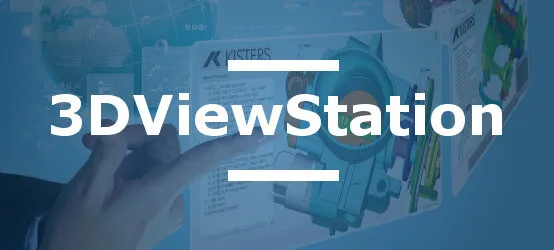CAD Interop: Unraveling the Power of Advanced CAD Analysis
In a French engineering workshop, a team tasked with validating a complex assembly of 12,000 parts consistently found themselves at an impasse. Each modification required nearly 15 minutes of waiting time to load the complete model, tripling validation timelines. This situation, far from isolated, perfectly illustrates the daily challenge of CAD model analysis in modern manufacturing industries.
With the explosion in industrial product complexity, the limitations of traditional systems have become evident. Engineers and technicians must juggle incompatible proprietary formats, endure prohibitive loading times, and often settle for superficial analyses due to inadequate tools. This reality significantly hampers innovation and compromises time-to-market objectives.
High-performance visualization and in-depth analysis of 3D models now represent a strategic competitive advantage. Specialized solutions like 3DViewStation Desktop radically transform this equation by offering:
- Ultra-fast opening of voluminous assemblies (up to 20,000 parts in seconds)
- Native compatibility with all major CAD formats (CATIA, NX, Creo, SolidWorks, JT, STEP, IGES and over 30 others)
- Advanced analysis features accessible without specialized training
- Light system footprint operating on standard computer configurations
The capabilities for dimensional analysis, collision detection, thickness analysis, and version comparison now enable all product lifecycle stakeholders to instantly access critical information without depending on CAD specialists. This democratization of 3D data access generates quantifiable business benefits:
- Up to 70% reduction in software license costs
- 80% decrease in time devoted to technical analyses
- Acceleration of development cycles by an average of 34%
- Significant reduction in design errors and non-quality costs
- Return on investment typically achieved in less than 6 months
The true revolution lies in this new approach that transforms CAD interoperability from a technical problem into a genuine catalyst for operational efficiency. The proposed solutions integrate naturally into your existing IT ecosystem, whether PLM systems, ERP, or specific business applications.
Explore the detailed articles in this category to discover how CAD model analysis solutions can precisely solve your specific challenges, whether accelerated design reviews, in-depth technical analyses, or multidisciplinary collaboration. You'll find the keys to transforming your product development process and gaining that decisive competitive advantage sought by every innovative manufacturing company.
“Tuesday, 2:30 p.m.: Emergency meeting with the client. Pierre, the project manager, clicks on the 2 GB CAD model. Nothing appears. He waits... 3 minutes... 5 minutes... The clients are getting impatient. The presentation is postponed.” This scene, experienced daily in the industry, costs millions in missed opportunities and production delays.
Now imagine that same model opening in less than a second. Without expensive licenses. On any standard computer. Without specific training for the 70% of employees who need access to 3D models without being CAD experts.
This isn't science fiction. It's the reality offered by modern ultra-fast visualization solutions that transform minutes of waiting into milliseconds of productivity.
What if your next client meeting took place without any downtime?
"Monday morning, 9:12 a.m.: Jean, a quality manager, receives an urgent call from a customer reporting an assembly issue. He needs to verify the dimensions of a critical component in a 180 MB model. Problem: all CAD licenses are in use. Solution? Wait or postpone the analysis for several hours..."
This situation, experienced daily in the industry, costs thousands of euros in delays and missed opportunities. Yet, with a simple tool like 3DViewStation, any employee can instantly measure distances, angles, surfaces, or thicknesses on complex CAD models.
Imagine being able to load a 300 MB Catia model in seconds, perform precise measurements with a single click, and share these results without a CAD license or training. From aeronautical engineers to automotive technicians, this approach is revolutionizing access to technical data.
What if the democratization of 3D measurements was your next competitive advantage?
The precise and rapid comparison of CAD models constitutes a critical step in modern industrial development processes. Faced with increasing demands for quality, compliance, and efficiency, professionals are looking for high-performance solutions capable of quickly processing complex models from different sources. To address these challenges, it is essential to identify the simplest and fastest solution for effectively comparing two CAD models.
The major challenge is to accurately spot differences between multiple versions of the same model or between files from different CAD systems. This comparative analysis allows for validating design changes, ensuring compliance with specifications, and identifying potential anomalies. But how do you choose the optimal tool to perform this fundamental task?
Wall thickness analysis represents a critical challenge in the CAD model design and validation process. This technique allows precise identification of areas with structural risks before manufacturing, thus avoiding considerable costs related to undetected defects. According to recent industrial data, up to 67% of manufactured product failures are directly linked to uncontrolled thickness variations during the design phase.
For engineers and designers, thickness analysis constitutes a decisive step to ensure manufacturability, strength, and durability of parts. However, in an industrial ecosystem characterized by multiple CAD formats, this analysis often becomes complex and time-consuming.
"Tuesday, 8:30 a.m. The car factory suddenly shuts down. 5,000 plastic parts are stuck in the molds, impossible to remove. Estimated cost: €120,000 in lost production and a 3-week delay. The cause? An insufficient draft angle of only 1.5° instead of the required 2.5°."
This catastrophic scenario, experienced by countless manufacturers, could have been avoided with a simple draft analysis during the design phase. As case studies show, a minimal difference in wall slope can turn a success into a costly disaster.
Draft analysis is a simple yet powerful preventative technique that accurately identifies problem areas before manufacturing, ensuring that each part can be removed from the mold without excessive friction or deformation.
What if a simple color code on your CAD model could prevent the next production shutdown?
"Monday, 7:30 a.m. The Toulouse factory is in turmoil. An assembly defect has just been discovered on the latest series of aircraft: two parts overlap by 2.7 mm at the junction of a wing. Production has been halted. Estimated cost: €1.2 million and a 90-day delay. In the crisis room, Pierre, the design manager, whispers: 'If only we had checked the collisions on the digital model..."
This true story illustrates the nightmare that manufacturers regularly experience. In a world where complex assemblies can contain up to 20,000 components from 7 to 12 different CAD systems, interference detection has become an absolute necessity.
Yet the solution exists and is surprisingly simple to implement. It can detect in seconds what would cost weeks and a fortune to correct later.
What if your next production crisis never happened?
In 2016, an automotive engineer discovered a critical gap between a wiring harness and an oil line... three weeks before production launch. The cost of the emergency modification: €2.3 million. If only distance band analysis had been used.
Imagine transforming your complex CAD model into an intuitive heat map, where colors instantly reveal all critical gaps. Distance band analysis does just that—it converts abstract numerical measurements into visual signals that anyone can understand at a glance. No more sleepless nights verifying hundreds of measurements, no more interference discovered on the physical prototype.
What if a simple color code could save your next project?
The comparison of technical drawings is a daily challenge for design offices and methods departments. With the multiplication of revisions and the acceleration of development cycles, quickly identifying changes between two versions of a drawing becomes a decisive factor for productivity. A recent study reveals that engineers spend up to 15% of their time manually checking drawings, a method that is not only time-consuming but also a potential source of critical errors. Fortunately, modern solutions now allow for automating this essential task.


